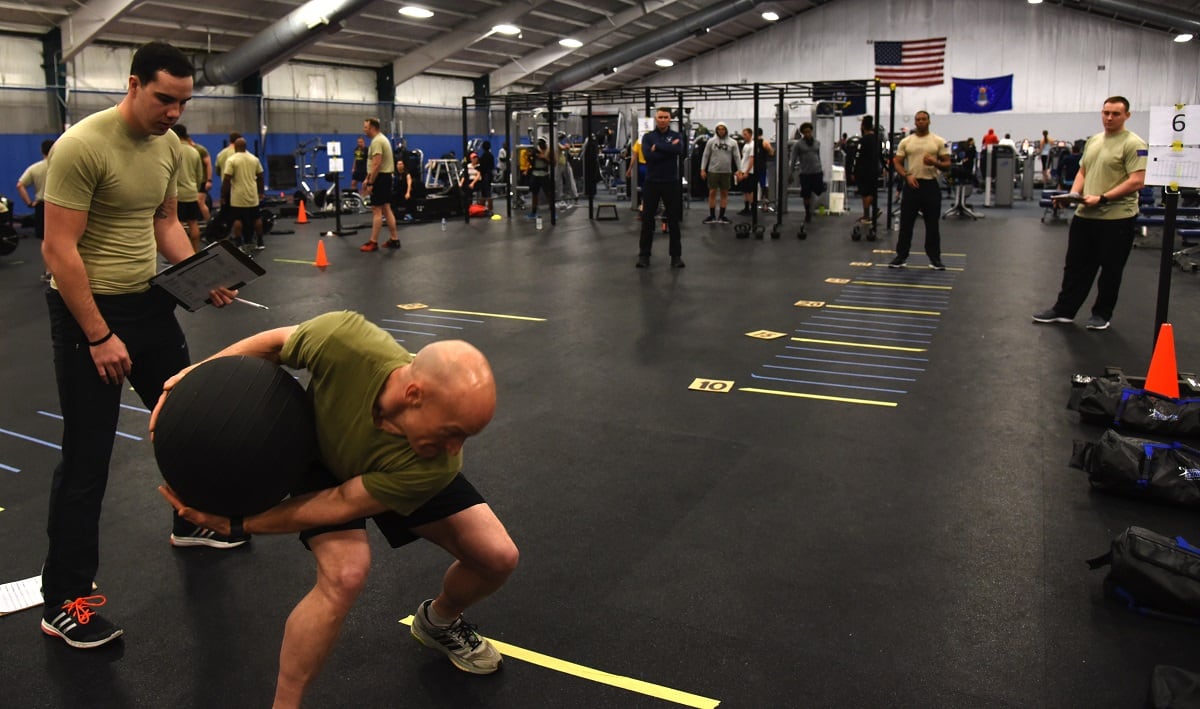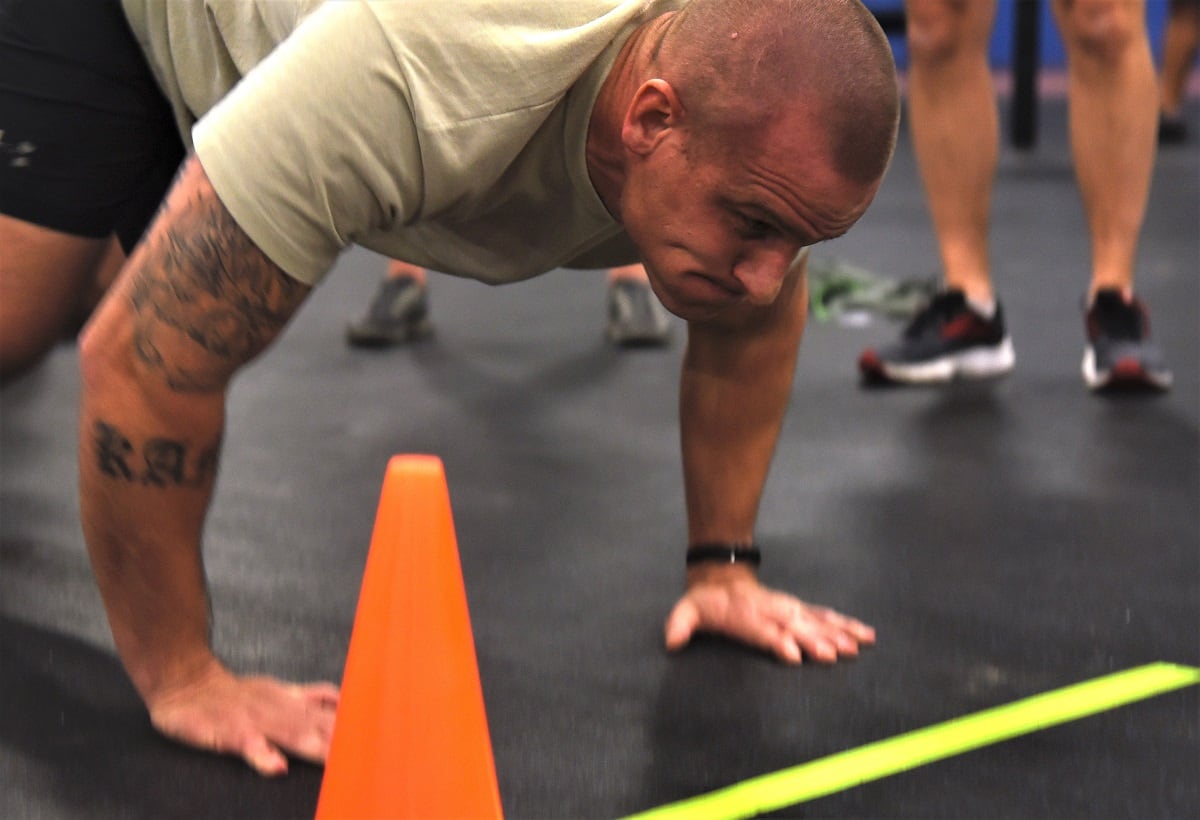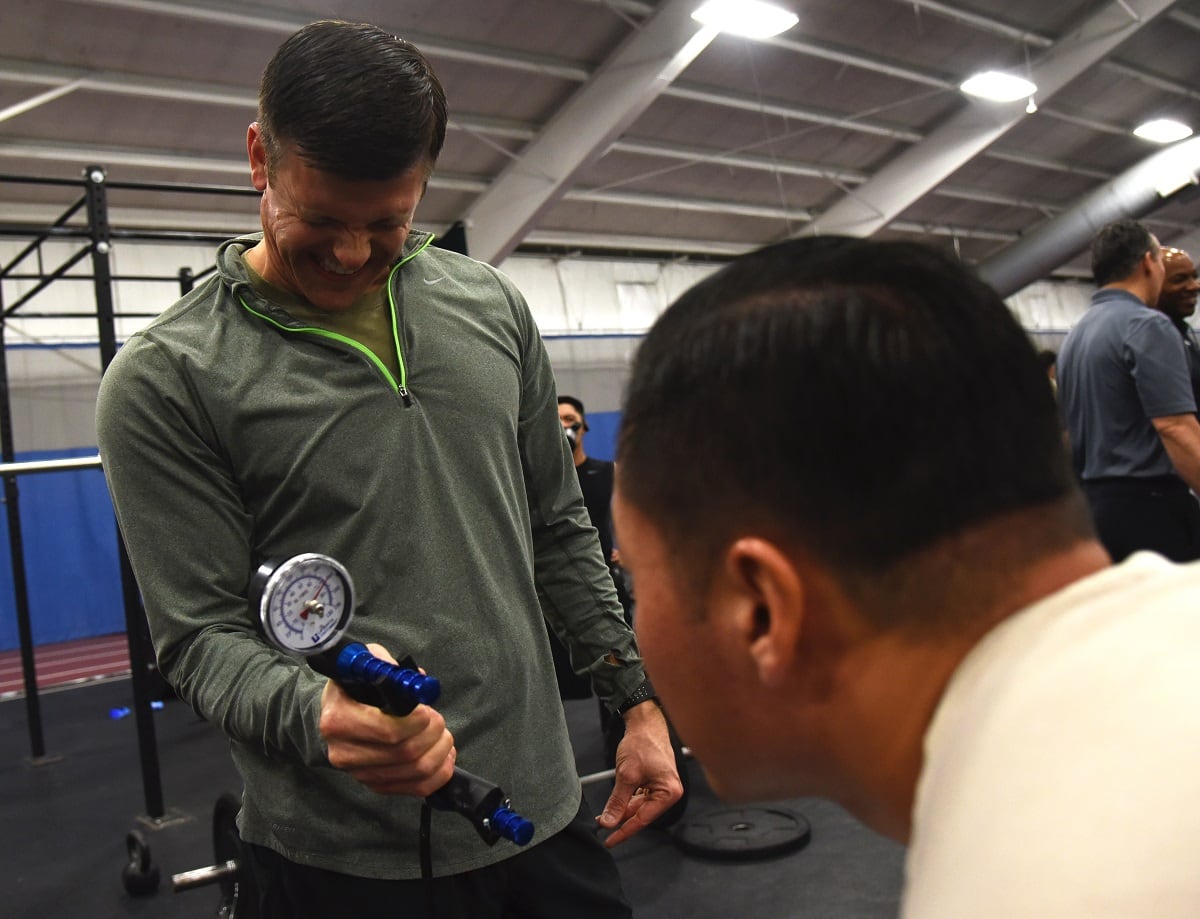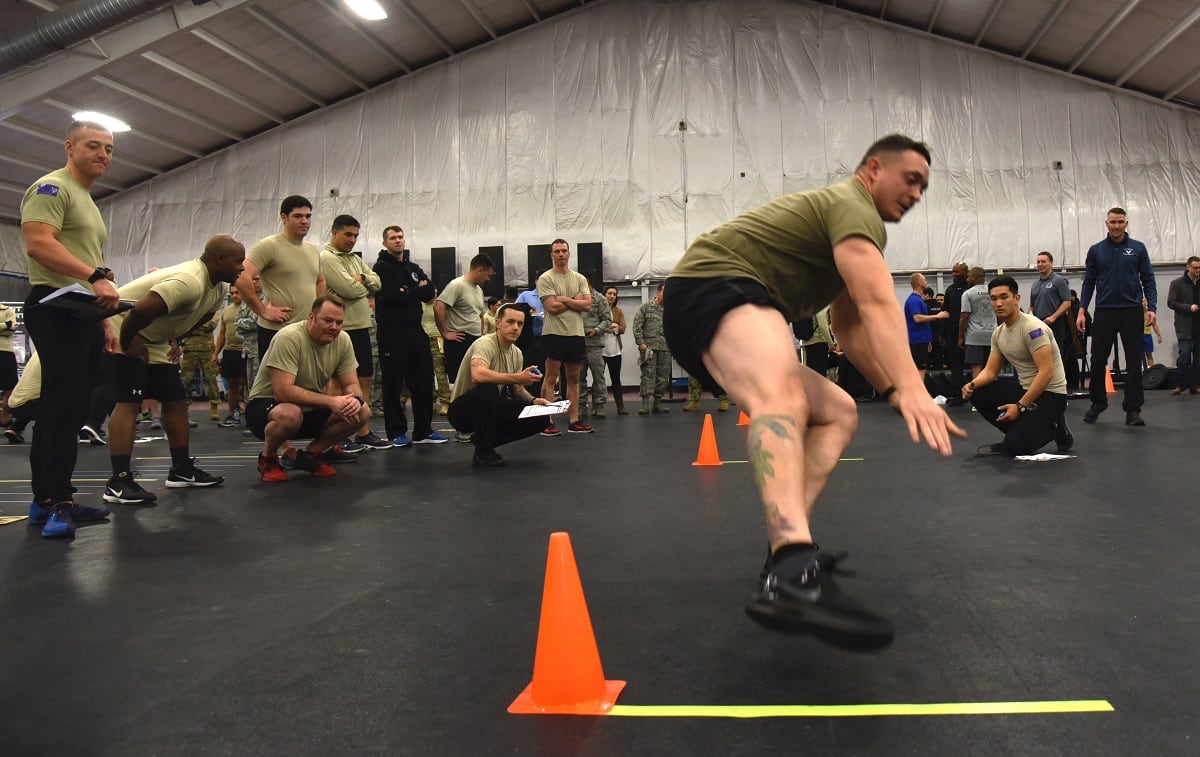JOINT BASE ANDREWS, Maryland — In a gymnasium here on Jan. 9, about 100 tactical air control party airmen got a glimpse of the future of their fitness test — and possibly yours.
Some ran figure-eights around cones to test their agility, leaning heavily to one side as they curved around, lightly touching the floor to maintain their balance. One TACP’s feet slipped out from under him, and he skidded on the ground, prompting laughter and a pained “Oh!” from his fellow TACPs.
Another planted his feet, gave a 20-pound medicine ball a few test swings, and flung it behind him and over his head. He turned around, glanced at how far it had gone, and muttered disappointingly, “I threw it too high.”
Those were just two events in a new test designed to measure the Air Force’s first career field-specific physical fitness standards — called Tier 2 standards.
The test, which is being finalized now, seeks to evaluate how well TACP airmen and their officer equivalents, air liaison officers, can perform the physical tasks required for their jobs.
The test is expected to go into effect sometime next year. And other physically active career fields — both inside and out of the battlefield airmen community — could follow with their own specialized standards.
Neil Baumgartner, chief of the Air Force’s exercise science unit, who led the design of Tier 2 standards, said that the Air Force is well on its way to establishing career field-specific standards for two other battlefield jobs — combat rescue officers and pararescuemen.
The Air Force is also working on standards for explosive ordnance disposal airmen, who are not considered battlefield airmen.
By the end of 2018, Baumgartner hopes those three jobs will have established at least prototypes of their own standards.
Job-specific standards are also in the works for the remaining battlefield jobs: special tactics officers, combat controllers, and special operations weather.
The Air Force is considering crafting similar standards for other jobs that require physical activity but don’t fall in the special tactics or battlefield airmen categories. That could include firefighters, security forces, SERE, loadmasters, civil engineers, and others.
“The task going forward is to take this goodness into the other occupational communities within the battlefield airmen community,” said Col. William Fischer, chief of the military force policy division. “And then there’s other communities that we feel also have very specific, occupationally based physical requirements. I think you’ll see this kind of Tier 2 test go out to other career fields.
“As we finalize this first wave, we’re going to take that feedback and engage other communities in the Air Force and find out if this kind of science would apply and benefit their communities.”
It’s crucial to tailor each Tier 2 standard to the specific requirements of each career field, Baumgartner said.
“You have wide ranges of requirements across the” career fields in the Air Force, Baumgartner said. “What a TACP has to do on the battlefield is dramatically different than even what another battlefield airman has to do, let alone the rest of the Air Force.”

Fit to fight
The Air Force kicked off its rollout of the Tier 2 standards with demonstrations Jan. 8-9 to the group of TACPs, who were in the Washington area for a summit of senior enlisted TACPs.
Over the next few months, the Air Force’s personnel office and other organizations will finalize the policy rules.
Policy decisions that have not been finalized include what happens if someone fails a test and isn’t qualified to go downrange, and how long they will have to correct that problem.
Chief Master Sgt. Matthew Nugent, the Air Force’s TACP career field manager, said one option could be to allow TACPs three chances to pass, and then either separate them or reclassify them into another job.
In rare cases, Nugent said, commanders could have the option of issuing a waiver for a TACP who fails the test but has the potential to come back and qualify in the future.
Maj. Justin Bañez, the Air Force’s career field manager for ALOs, said TACPs will likely have to take the test annually, and it will probably be at random to make sure they are fit year-round.
By the time 2019 begins, the new PT standards are expected to be fully in effect, said Bañez, who also is the close air support branch chief.
Baumgartner has been thinking about how to establish these kinds of standards for about two decades, but the Air Force has been working on it in earnest since about 2013.
It’s not just about determining physical fitness, Fischer said. The new tests will make sure the TACPs are the best TACPs they can be.
“In the end, we think we’re going to get better TACPs out of projects like this,” Fischer said.
Nugent said the tougher standards will also build young TACPs’ confidence that they will be able to handle the grueling physical challenges they’ll encounter on their first deployment.
“Before I deployed [for the first time], I was required to be Tier 1 compliant,” Nugent said. “Pushups, situps, and a 1.5-mile run, I didn’t have the confidence going into combat from that test.
“This test gives you confidence. If you watch our NCOs taking this test, if you watch the sweat and the exertion … when they’re done, [they’ll say] ‘Hey, I feel confident going into combat.’ If you’re confident going into combat, then you’re going to kill the enemy and break stuff.”

Higher standards
The Tier 2 standards are intended to set a minimum baseline of strength, speed, agility, and endurance necessary for TACPs and ALOs to be able to do their jobs.
Unlike the regular fitness standards, which all other airmen are required to meet and are now referred to as Tier 1 standards, Tier 2 standards are the same no matter what gender or age an airman is — either they can do the job, or they can’t.
“The Tier 1 PT test is a health-based test,” Bañez said. “It makes sure you are healthy and determines your risk for cardiovascular disease, but it’s not necessarily a good predictor of your ability to do your job. The Tier 2 test focuses on what your career field requirements are — what are your critical physical tasks. For a TACP, that could range anywhere from having to pull my buddy who gets shot, to be able to climb over obstacles, or into a helicopter, those types of things. This test is supposed to be predictive of your ability to do those types of tasks.”
The Tier 2 tests have also been designed to take into account the heavy equipment TACPs wear, which means airmen will perform these tests in their regular PT gear — not in battle rattle.
The only component both tests have in common — the 1.5-mile run — is much tougher under the new standards.
In the Air Force-wide Tier 1 test, men under 30 must run that distance in no more than 13 minutes and 36 seconds to avoid failing.
But to avoid failing the Tier 2 test, a TACP or ALO must run 1.5 miles in 11:31 or less.
The TACP and ALO test drops the pushups and situps all other airmen must now do.
The other nine components of the new test include a 1,000-meter row, a 100-yard farmer’s carry, an extended cross knee crunch, weighted lunges, pullups, a trap bar deadlift with five repetitions, a two-cone agility drill, a medicine ball toss, and a grip strength test.
In November, the Air Force exempted TACPs and ALOs from having to take most Tier 1 tests. The one exception was the abdominal circumference, or tape test, which will still be required.
TACPs and ALOs will get anywhere from 1 to 10 points on each component, and must score a total of at least 46 points out of 100 to pass.
However, anyone who scores a 1 in any component automatically fails the test.

The components “are all linked,” Bañez said. “Not being able to do any one thing would be indicative of a risk to your ability to do your job. A guy can be really good at lifting heavy weights, but if I need him to ruck to the objective, three or four miles, and he can’t do it, then he’s not really effective. You need a good balance across the board.”
Nugent also said it’s important to maintain these standards because TACPs can get up to $525 a month in incentive pays.
If the Air Force is paying out that money to a TACP, it needs to be sure he can deploy and do the job when called upon.
The tests also will make sure TACPs aren’t hiding any injuries that the Tier 1 standards might not reveal, Nugent said.
“If you’re a young staff sergeant with two children, and you’re earning [hundreds of dollars] a month in proficiency pays, and you come back from a deployment and you’re hurt, you’re going to be more reluctant to say something about your injuries,” Nugent said. “And you may mask those injuries because you don’t want to lose proficiency pay.
“This test forces our guys to have those conversations, because you can’t hide behind Tier 1 anymore. If I know you’re struggling with this event — ‘Hey what is going on?’ ‘Well, Chief, I didn’t want to tell you, but I’ve got a lower back injury.’ So, it provides a good look in the mirror.”

Feedback from the field
To set up these standards, Air Force officials sat down with TACPs and ALOs to collect a list of real-world scenarios and mission requirements.
“Whatever they needed to do regularly in the field, [Baumgartner] then took those muscle groups and those muscle movements and went from there,” Air Force spokeswoman Brooke Brzozowske said.
This included requirements like being able to move while carrying 65 pounds of radios, batteries and other heavy equipment on their backs, Bañez said.
The Air Force studied airmen doing those kinds of tasks in full gear in simulated battlefield scenarios, and then studied those same airmen doing exercises in PT gear with standard exercise equipment.
Officials then looked at the results to see which exercise results correlated with success in the simulated battlefield tasks, and used those correlations to build the Tier 2 requirements.
For example, the two-cone drill is meant to measure TACPs’ agility, balance and coordination.
In combat, a TACP under fire might have to stay low and “move from a covered position, to another covered position, return fire, maybe have to go grab something,” Bañez said. “Especially as TACPs — we’re on the battlefield in close proximity to the enemy, and oftentimes we have to maneuver to get to a better vantage point to be able to call in close-air support. We may have to grab a buddy that’s down.”

TACPs also carry a much heavier load than most troops on the battlefield, Nugent said.
Not only do they have to carry the same body armor, weapons and ammunition as other troops, but they also have to carry multiple radios and batteries necessary to call in airstrikes when things get hot.
What’s more, Fischer said, sometimes they have to move up steep inclines such as the mountains of Afghanistan while carrying that weight. Other times, they’ll have to drop to take cover from incoming fire, and then get up quickly and repeatedly to move to another location, all while being weighted down with all that equipment.
That’s why the test includes weighted lunges, performed to a metronome ticking at 56 beats per minute with a 50-pound sandbag on their back.
The Air Force found that such weighted lunges would be an effective way to measure how well TACPs would perform those physical tasks under that weight.
The medicine ball exercise is meant to track how effectively a TACP can lift and move heavy equipment in the field, or toss a sandbag when setting up a base.
The trap bar deadlift — where TACPs must lift at least 276 pounds five times — requires tremendous lower body strength and could translate to having to lift an injured comrade on the battlefield, Fischer and Nugent said.
“What happens when one of your buddies to your left or your right goes down?” Nugent said. “And now you’re dragging him away from the battlefield to get him to a safe place to administer combat aid. That right there is a measure of that ability. Lower body strength is important.”
The Air Force considered a one-rep test, but ultimately decided on five repetitions to measure endurance as well as strength.
“What good are you on the battlefield if I get you somewhere and you can only do something once?” Fischer said.
Bañez said airmen in the TACP and ALO career fields have known that these standards have been coming for the past two years or so and have been training to them already.
The Air Force has also been providing the necessary equipment, such as the particular size and type of Dynamax medicine balls required and hand grip dynamometer.
Strength and conditioning coaches and physical therapists embedded in the units are building their training programs to make sure airmen are focused on the right elements, and not too-long runs or “beach body muscles,” Bañez said.
And, Fischer said, the coaches and therapists will be paying closer attention to how airmen exercise before the test to make sure they train more efficiently and safely.
“We’re able to be smarter about our physical fitness — not just sweating for sweating’s sake,” Fischer said. “We can catch problems before they magnify” and turn into injuries.
Stephen Losey is the air warfare reporter for Defense News. He previously covered leadership and personnel issues at Air Force Times, and the Pentagon, special operations and air warfare at Military.com. He has traveled to the Middle East to cover U.S. Air Force operations.





